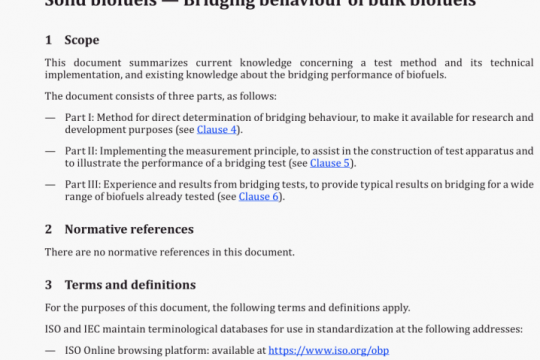AS ISO 10987 pdf free download
AS ISO 10987-2021 pdf free download.Earth-moving machinery一Sustainability 一Terminology, sustainability factors and reporting.
4.2 Work-site energy efficiency
The work-site energy efficiency factor is defined as the energy used for the work done to complete the project. It is generally expressed in units of material moved per amount of energy used/fuel consumed. Common units are cubic metres or tonnes of material per kilowatt hour of energy used. For some applications, the distance that material is moved can be an important parameter, so the energy efficiency could be given in units of cubic metres or tonnes of material per distance in metres per kWh energy used. Determining energy efficiency for machines requires measuring both their energy use and the machine productivity.
The contributions of individual machines to the work-site energy efficiency can be estimated by the energy use/fuel consumption of machines versus the amount of work done. The amount of energy/fuel that a machine uses depends upon the particular application and on the machine load factor for the application. An example of a method for estimating machine energy efficiency is provided in Annex B.
4.3 Work-site greenhouse gas emissions
The work-site greenhouse gas (GHG) emissions factor for earth-moving-machinery consists of GHGs generated as a by-product of the energy/fuels used within earth-moving machines on a project to complete the work. This source of work-site GHG emissions considered includes the use of earth-moving machinery within the boundaries of a worksite over a typical eight-hour workday and does not include GHG emissions attributed to any additional stages of a product’s lifecycle. GHG emissions from all forms of energy/fuel used, such as fossil fuels, renewable fuels and electrical power, should be included in the accounting to determine the total of GHGs generated.
[lydrofluorocarbon emissions potentially associated with leakage and service within the worksite boundary on machines fitted with air conditioning should be identified by listing the amount of refrigerant charge in the air-conditioning system in kilograms.
© Standards Australia Limited 2021
5 AS1S010987:2021
4.4 Product support for improving machine efficiency and use
The work-site energy efficiency and resulting work-site GHG emission for earth-moving-machine applications vary significantly depending upon the skill of and technique used by the operator, as well as the specific work-site operations. Operator training and work-site management aids can be used to improve the energy efficiency for machines. Manufacturers should provide operator training instruction and work-site operation aids that can enable the improvement of the machine application efficiency. Such information and aids provide an immediate short-term opportunity for work sites to reduce the amount of GHGs.
NOTE Experience has shown that the most significant improvement in sustainability is from operator training and work-site management.
4.5 Machine air quality emissions
The machine air quality emissions factor refers to the engine emissions measured during engine emissions testing. The air quality emissions factor can be defined by providing the engine emissions level, such as the tier or stage level. These ratings define the maximum engine emission levels for nitrogen oxide (NOr), hydrocarbon (HC), carbon monoxide (CO) and particulate matter (PM).
4.6 Machine material re-use, recyclability and recoverability
The machine material re-use factor provides information related to disposing of or dismantling machines at the end of their life. The three material re-use categories are as follows:
— remanufactureable content is the percentage of the machine mass that could be used again after a remanufactu ring process in accordance with ISO 16714;
— recyclable content is the percentage of a machine that could be recycled in accordance with ISO 16714;
— recoverability is the percentage of the machine that can be diverted from an end-of-life stream to be recovered in accordance with ISO 16714.
4.7 Safety
The safety sustainability factor for earth-moving machinery shows that a machine has been developed to be safely used during its useful life with trained operators, maintained machines and safe work- site organization. International Standards are available that define the technical performance parameters for earth-moving machinery safety, and machine safety levels may be determined by listing the standards with which the machine is compliant. ISO 20474 is one such standard addressing significant safety aspects of earth-moving machines. National or regional standards may also be listed, as appropriate.
4.8 Sound and vibration
The sound and vibration factor provides information relative to the sound and vibration levels of machines. Machine sound levels, if included in the sustainability factor information, shall be according to the test methods specified in ISO 6393, ISO 6394, ISO 6395 and ISO 6396 for both the operator of, and spectators around, the machine. Machine vibration levels should be estimated using ISO/TR 25398 for whole body vibration and ISO 5349-2 for hand and arm vibration.
4.9 Total useful life cost parameters
The total useful life cost information allows machine users to calculate the cost of an earth-moving machine during its useful life, for estimating the cost of the machine for work projects. The total useful life cost is the cost of owning and operating a machine relative to its productivity on a work project.AS ISO 10987 pdf download.




